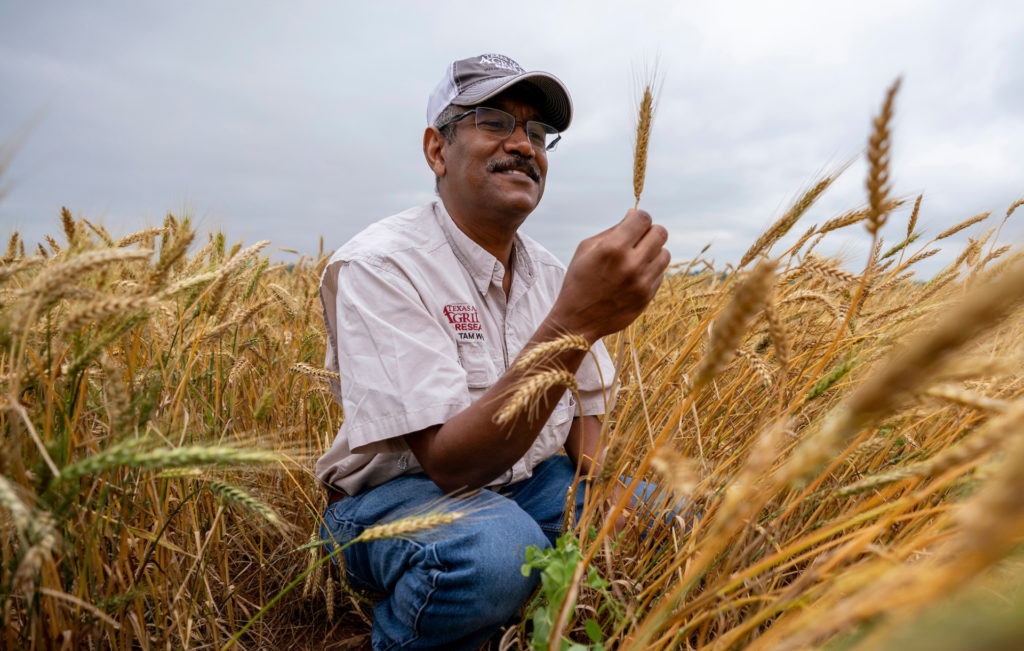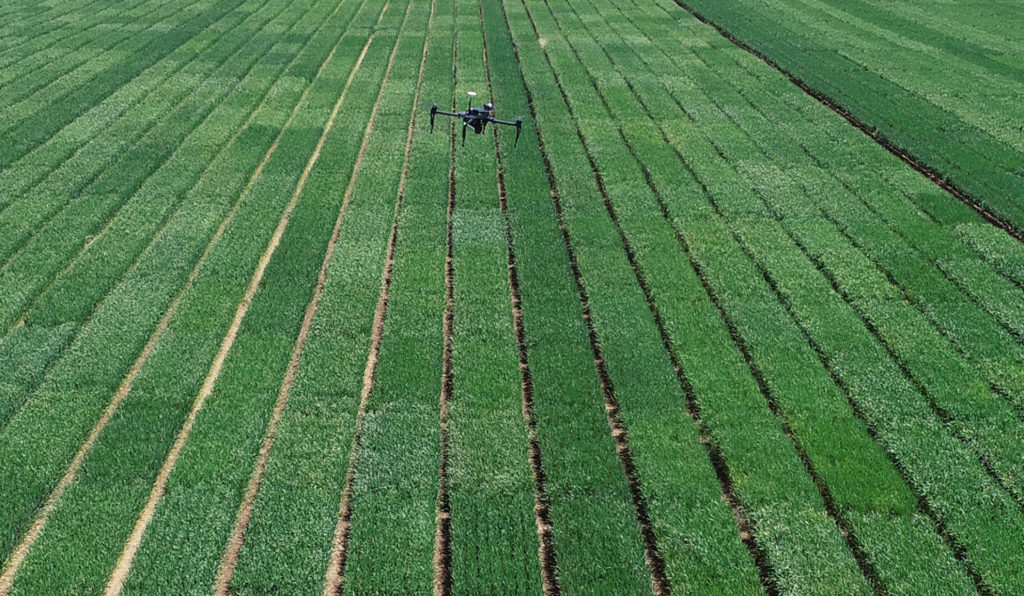Texas to lead drone data processing as part of $15 million national wheat project
Texas A&M AgriLife team selected to compile data of 19 universities’ public wheat breeding programs
Texas A&M AgriLife will lead the creation of an unmanned aircraft system, UAS, data hub as a component of a $15 million grant that brings together the strengths of the public wheat breeding programs in 19 universities across the U.S.

This is the fourth U.S. Department of Agriculture National Institute of Food and Agriculture award supporting the Wheat Coordinated Agricultural Project, WheatCAP, consortium for research on yield. The overall goals for this project are the validation, characterization and deployment of phenotypic traits for improving grain yield components and training the next generation of plant breeders.
The recently announced WheatCAP 2022-2026 grant is $3 million per year for five years. The project is led by the University of California, Davis.
Public development of progressive wheat cultivars
The WheatCAP is designed to establish a nationally coordinated consortium of public wheat breeders, molecular geneticists, database experts, educators, and high-throughput genotyping and phenotyping laboratories focused on sustainable increases in wheat productivity.
Wheat differs from other major crops grown in the U.S. in that public breeding programs play an active role in developing commercial varieties. While most U.S. corn and soybean varieties and hybrids are developed by private breeding programs, most U.S. commercial wheat varieties are developed by the public sector.
A continuous increase in the productivity of public wheat varieties is required to maintain the competitiveness of U.S. wheat growers.
During WheatCAP 2017-2021, researchers developed exome capture datasets, imputation tools, functional genomics resources, and an integrated, public repository of wheat data, the T3/BreedBase hub.
Texas A&M AgriLife populates T3 hub
The Texas A&M AgriLife team will now develop a data management system capable of processing, analyzing and delivering high-throughput phenotyping, HTP, data gathered by unmanned aircraft vehicles, UAVs, and sensors to populate the T3/Breedbase.

The Texas team includes wheat breeders Amir Ibrahim, Ph.D., Bryan-College Station, who serve as AgriLife Research’s lead, and Jackie Rudd, Ph.D., Amarillo; Juan Landivar, Ph.D., Texas A&M AgriLife Research and Extension Center director, Mahendra Bhandari, Ph.D., remote-sensing crop physiologist, and Jose Scott, engineer/programmer, all at Corpus Christi; Shuyu Liu, Ph.D., geneticist, and Shannon Baker, certified pilot and program manager, both at Amarillo; Russ Garetson, certified pilot and AgriLife Extension program specialist, Bryan-College Station.
The team also includes Jinha Jung, Ph.D., assistant professor of civil engineering, Purdue University, who was an AgriLife Research scientist in Corpus Christi and a key part to building the data analysis and interpretation part of the Texas A&M AgriLife UAV pipeline.
“The multidisciplinary AgriLife Research-Digital Agriculture Program is one of the largest in the U.S., utilizing both fixed-wing and rotary-wing aircraft as part of research activities at centers in Weslaco, Lubbock, Stephenville, Corpus Christi, College Station and Amarillo,” Landivar said. “Because of our capability to analyze large volumes of data, we were chosen to lead the UAS portion of the WheatCAP.”
Ibrahim said they will use a pipeline already developed by the group, which includes an automated data processing workflow.
“This pipeline uses UAS data collected over the growing season to extract plant height, canopy cover, canopy volume and vegetation indices for wheat,” he said.

Participating programs will collect raw data using their UAS and sensors and upload it to a central hub in Texas. The hub will process that information into geospatial Level 1 and Level 2 data, send the plot/grid level phenotypic data back to the breeder, and also add it into T3/BreedBase.
Having this centralized data portal helps breeders share data and standardizes data processing procedures to obtain high quality data products from all the breeding programs throughout the growing season, Bhandari said.
“Standardized high spatio-temporal resolution data collected over the growing season at multiple locations will enhance our understanding of growth dynamics and genotype x environment interactions,” he said.
Wheat breeders from the 19 universities can submit up to 2 acres of raw images to be processed for free by a centralized pipeline. The Texas A&M team will coordinate technical aspects of drone data collection and submission for all the breeding programs, and data collection will begin this month.
“Processing big data is a bottleneck for many programs, but Texas has made a lot of progress in this area, and the processing is automated,” Ibrahim said. “Some programs will send raw data and others will be more advanced.”
Rudd said UAS phenotyping and genotyping will not replace the need for breeders to walk through wheat fields and analyze what comes through the combine. However, obtaining a greater set of data will create a more complete picture and lead to more discoveries.
Another large component of this project will be to involve students in many areas of the research as well as courses, workshops, conferences and webinars. These students will be trained in all aspects of traditional plant breeding and equipped with experience in and knowledge of the newest technology.
Building upon collaboration
Rudd said the T3/Breedbase is an open database, and collaboration among programs is encouraged. In addition to the UAS data, the database will also contain genotyping data from the same set of breeding lines. The performance data will be related to the genetic data for a more complete understanding of how to introgress valuable traits into new varieties and breeding lines.
“Instead of having just the Texas A&M data, we will have access to 18 other programs that we can coordinate with on yield and disease data,” he said. “Our goal is not just to store data, but also to make it accessible by all the programs. It is extremely valuable for us to interact with one another to breed the best varieties for the future.”
Ibrahim said the project will bring greater efficiency to the breeding process.
“We can look at more lines in the field in less time,” he said. “This should increase breeding efficiency and ultimately benefit the producer as we translate into higher yield, quality and tolerance to disease and antibiotic stresses.”
The biggest benefits of the project may still be unknown, though, the breeders said.
“Wheat breeding programs across the U.S. collecting and sharing their performance and genetic data is an incredible opportunity,” Rudd said. “So, what is the bigger dataset going to tell us that we were not getting from the smaller datasets? This provides data that we were not able to gather before, and when everyone starts looking at that, then we may discover even greater benefits.
“The repeatability, looking at different classes of wheat across diverse environments – we don’t exactly know what it will look like, but we are excited about what we will find,” he said. “We’ve been very successful with new varieties so far, and this will be important to help us continue the legacy of superior cultivars that are widely adopted.”
The ultimate beneficiaries of this program will be the producers and the consumers.
“The varieties will be improved with increased frequencies, so the odds are improved of getting a royal flush instead of just a full house,” Rudd said. “This allows the producer to get more yield with the same inputs. New varieties are more efficient in the use of water, nitrogen and other resources, so more environmentally friendly. And the consumer still gets the products they love.”
As breeding efficiency increases, breeders will be able to focus on issues beyond just yield and pest resistance – they can improve qualities such as nutrition, flavor and aroma profiles, he said.


